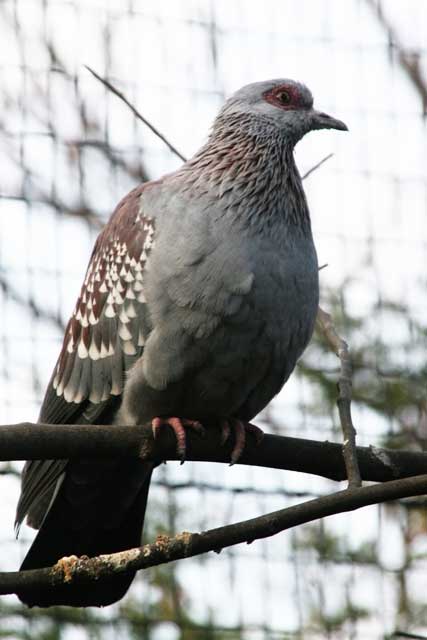
Columba guinea (*)
Superregnum: Eukaryota
Cladus: Unikonta
Cladus: Opisthokonta
Cladus: Holozoa
Regnum: Animalia
Subregnum: Eumetazoa
Cladus: Bilateria
Cladus: Nephrozoa
Superphylum: Deuterostomia
Phylum: Chordata
Subphylum: Vertebrata
Infraphylum: Gnathostomata
Megaclassis: Osteichthyes
Cladus: Sarcopterygii
Cladus: Rhipidistia
Cladus: Tetrapodomorpha
Cladus: Eotetrapodiformes
Cladus: Elpistostegalia
Superclassis: Tetrapoda
Cladus: Reptiliomorpha
Cladus: Amniota
Classis: Reptilia
Cladus: Eureptilia
Cladus: Romeriida
Subclassis: Diapsida
Cladus: Sauria
Infraclassis: Archosauromorpha
Cladus: Crurotarsi
Divisio: Archosauria
Cladus: Avemetatarsalia
Cladus: Ornithodira
Subtaxon: Dinosauromorpha
Cladus: Dinosauriformes
Cladus: Dracohors
Cladus: Dinosauria
Ordo: Saurischia
Cladus: Eusaurischia
Subordo: Theropoda
Cladus: Neotheropoda
Cladus: Averostra
Cladus: Tetanurae
Cladus: Avetheropoda
Cladus: Coelurosauria
Cladus: Tyrannoraptora
Cladus: Maniraptoromorpha
Cladus: Maniraptoriformes
Cladus: Maniraptora
Cladus: Pennaraptora
Cladus: Paraves
Cladus: Eumaniraptora
Cladus: Avialae
Infraclassis: Aves
Cladus: Euavialae
Cladus: Avebrevicauda
Cladus: Pygostylia
Cladus: Ornithothoraces
Cladus: Ornithuromorpha
Cladus: Carinatae
Parvclassis: Neornithes
Cohors: Neognathae
Cladus: Neoaves
Cladus: Columbimorphae
Ordo: Columbiformes
Familia: Columbidae
Subfamilia: Columbinae
Genus: Columba
Species: Columba guinea
Subspecies: C. g. guinea – C. g. phaeonota
Name
Columba guinea Linnaeus, 1758
References
Linnaeus, C. 1758. Systema Naturae per regna tria naturæ, secundum classes, ordines, genera, species, cum characteribus, differentiis, synonymis, locis, Tomus I. Editio decima, reformata. Holmiæ: impensis direct. Laurentii Salvii. i–ii, 1–824 pp DOI: 10.5962/bhl.title.542: 163. Reference page.
Vernacular names
Afrikaans: Kransduif
azərbaycanca: Columba guinea
български: Гвинейски гълъб
català: Colom de Guinea
čeština: Holub skvrnitý
Cymraeg: Colomen frech
dansk: Guineadue
Deutsch: Guineataube
English: Speckled Pigeon
Esperanto: Lentuga kolombo
español: Paloma de Guinea
فارسی: کبوتر خالخالی
suomi: Afrikantäpläkyyhky
français: Pigeon roussard
客家語/Hak-kâ-ngî: Pân-kap
Hausa: Hazbiya
magyar: Csíkosnyakú galamb
հայերեն: Խատուտիկ աղավնի
italiano: Piccione di Guinea
Nederlands: Gespikkelde duif
norsk: Spragledue
polski: Gołąb okularowy
پنجابی: گنی کبوتر
português: Pombo-malhado
русский: Крапчатый голубь
svenska: Guineaduva
українська: Голуб цяткований
粵語: 斑鴿
The speckled pigeon (Columba guinea), or (African) rock pigeon, is a pigeon that is a resident breeding bird in much of Africa south of the Sahara. It is a common and widespread species in open habitats over much of its range, although there are sizable gaps in its distribution. It is sometimes referred to as the Guinea pigeon due to its similar coloring to some species of guineafowl.
Taxonomy
In 1747 the English naturalist George Edwards included a description and an illustration of the speckled pigeon in the second volume of his A Natural History of Uncommon Birds. His hand-coloured etching was made from two live birds at the home of the Duke of Richmond in London. Edwards was told that the pigeons had been brought from the inland region of Guinea in West Africa.[2] When in 1758 the Swedish naturalist Carl Linnaeus updated his Systema Naturae for the tenth edition, he placed the speckled pigeon with all the other pigeons in the genus Columba. Linnaeus included a brief description, coined the binomial name Columba guinea and cited Edwards' work.[3]
There are two recognised subspecies:[4]
C. g. guinea Linnaeus, 1758 – Mauritania to Ethiopia south to the Democratic Republic of the Congo and northern Malawi
C. g. phaeonota Gray, G.R., 1856 – southwestern Angola to Zimbabwe and South Africa
Nest box for Columba guinea in the wall of a homestead in Zerfenti, (Ethiopia)
Description
This is a large pigeon at 41 cm in length. Its back and wings are rufous, the latter heavily speckled with white spots. The rest of the upperparts and underparts are blue-grey, and the head is grey with red patches around the eye. The neck is brownish, streaked with white, and the legs are red. Sexes are similar, but immatures are browner than adults and lack the red eye patches. The call is a loud doo-doo-doo.
Behaviour and ecology
The speckled pigeon is frequently seen around human habitation and cultivation. Most of its food is vegetable, and it gathers in large numbers where grain or groundnuts are available. This species builds a large stick nest on protected rocky outcrops and in urban areas often atop covered pergola pillars and on flat roofs under deep eaves and lays two white eggs. Its flight is quick, with regular beats and an occasional sharp flick of the wings that are characteristic of pigeons in general.
Eggs, Collection Museum Wiesbaden
References
BirdLife International (2017). "Columba guinea". IUCN Red List of Threatened Species. 2017: e.T22690080A118855992. doi:10.2305/IUCN.UK.2017-3.RLTS.T22690080A118855992.en. Retrieved 13 November 2021.
Edwards, George (1747). A Natural History of Uncommon Birds. Vol. Part II. London: Printed for the author, at the College of Physicians. p. 75.
Linnaeus, Carl (1758). Systema Naturae per regna tria naturae, secundum classes, ordines, genera, species, cum characteribus, differentiis, synonymis, locis (in Latin). Vol. 1 (10th ed.). Holmiae:Laurentii Salvii. p. 163.
Gill, Frank; Donsker, David; Rasmussen, Pamela, eds. (July 2021). "Pigeons". IOC World Bird List Version 11.2. International Ornithologists' Union. Retrieved 9 October 2021.
Birds of the Gambia by Barlow, Wacher and Disley, ISBN 1-873403-32-1
Retrieved from "http://en.wikipedia.org/"
All text is available under the terms of the GNU Free Documentation License

